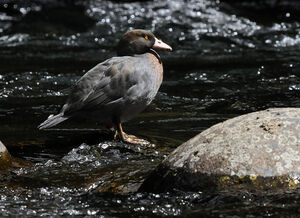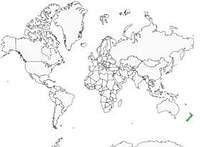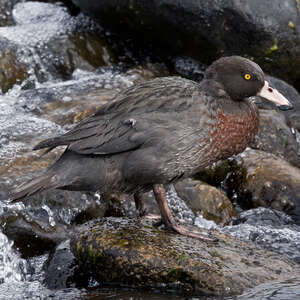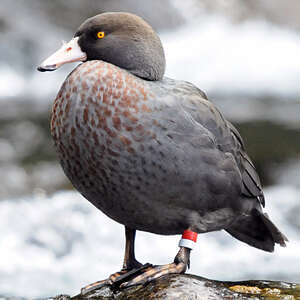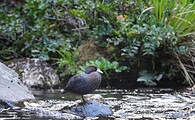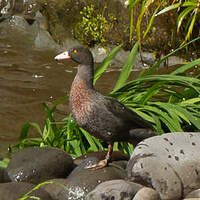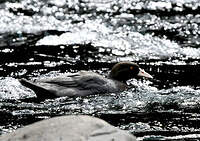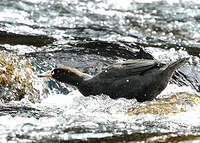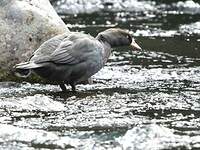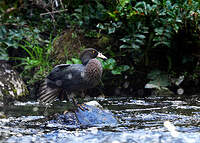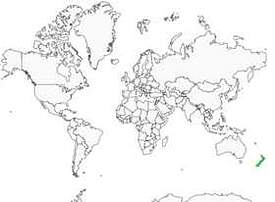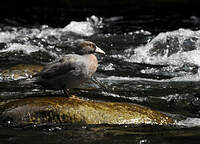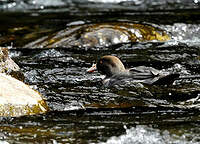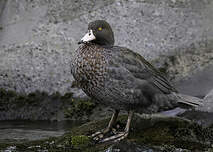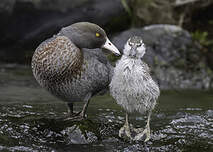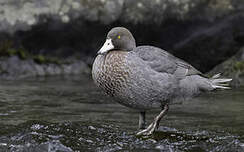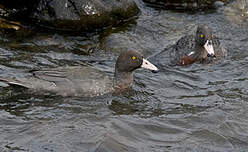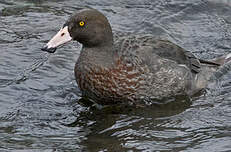Blue Duck
Hymenolaimus malacorhynchos - Canard bleu
Identification
The Blue Duck owes its Maori name whio to its song. It is an iconic species of the turbulent and clear rivers of New Zealand. Three species of Anatidae in the world live all year round on torrential rivers: the Blue Duck, the other two species are found in South America (Torrent Duck) and New Guinea (Salvadori Duck). The presence of this duck is an indicator of the quality of the waters of the rivers it frequents.
Adults of both sexes are similar, uniformly slate gray-blue with brown spots on the chest, a pale gray beak with a visible black flap extended at its end, dark gray legs, partially yellowish feet, eyes are yellow. During aggressive interactions, or when birds are suddenly frightened, the epithelium of the beak then strongly irrigated by blood turns pink. Males are larger than females, chest spots are larger, verdant iridescence is more pronounced on the head, neck and back of the male.
Juveniles are similar to adults, from the end of summer, their eyes are dark, their beak is dark gray, the chest is covered with sparse and dark spots.
Subspecific information 2 subspecies
- Hymenolaimus malacorhynchos malacorhynchos (New Zealand)
- Hymenolaimus malacorhynchos hymenolaimus ()
Foreign names
- Canard bleu,
- Pato azul,
- pato-azul-maori,
- Saumschnabelente,
- karimáscsőrű réce,
- Blauwe Eend,
- Anatra blu,
- blåand,
- Kaskadeand,
- vahia modrá,
- kachna měkkozobá,
- Newzealandsk Strømand,
- vuorisorsa,
- ànec blau,
- krzywonos,
- Синяя утка,
- アオヤマガモ,
- 山鸭,
- 山藍鴨,
Voice song and call
Habitat
Behaviour character trait
The Blue Duck does not migrate, it is very sedentary. Couples establish themselves in a territory that they occupy throughout the year and throughout their life. They are very territorial and vigorously defend this territory all year round. It covers from 1 to 2 kilometers of river. Their habits are marked, daily and regular. They feed for 1 to 1.5 hours, then rest at dawn to start again until mid-morning, then remain inactive until late afternoon and feed again before nightfall.
Dietfeeding habits
Food occupies about a quarter of the daily activity of the Blue Duck. Sometimes they feed at night. Food is sought mainly in shallow waters on the banks of rivers. They search for invertebrates captured on the rocks, dig up the gravel from the river bed and gather larvae and insects on the surface. Their diet is mainly composed of invertebrates: ephemerids, plecopters, chironomid larvae, phryganids, cecidomyies and trichopterans. They also feed on algal biomass near the banks.
Reproduction nesting
The Blue Duck nests in cavities, crevices, tree holes, or under dense vegetation, in isolated sites on river banks and up to 30 m away from them.
They can reproduce in their first year. The eggs, 3-7, usually 6, are laid from late August to October (recoketting in December if the first clutch fails). The white eggs are incubated by the female for 33-35 days. Nesting success is about 54%. Predation and flooding can lead to nesting failure. About 60% of ducklings reach flight. The two parents care for the young for 70-82 days until they take flight.Geographic range
Threats - protection
IUCN conservation status
concern
in the Wild
threatened
evaluated
It is extremely difficult to estimate the population of the Blue Duck due to its often inaccessible habitat. The latest population estimate is between 2,500 and 3,000 individuals with a maximum of 1,200 couples, although Williams estimated the population at 600 couples in 2005. However, a recent estimate gave around 640 couples for the North Island and 700 couples for the South Island (Young 2009). Population fragmentation reduces recolonization and prevents genetic mixing with other birds (Williams, 1988).
It is rapidly declining due to other factors, such as habitat loss, predation and human activity. Introduced mammals play an important role in the decline of the Blue Duck. Ermines, through predation, are certainly the most threatening species to females during nesting, eggs and ducklings. Rats and opossums are also likely to prey on eggs. Hare cats, domestic dogs and ferrets are also predators. Human activity can also adversely affect Blue Duck populations. When using waterways such as kayaking, fishing and hunting. The introduction of trout can lead to a decrease in food access (Heather and Robertson, 1997); birds caught in abandoned fishing lines have been reported (Young 2009). Habitat loss due to deforestation for agriculture leads to polluted rivers and a decrease in water quality. Some rivers are modified for hydroelectric power or irrigation, which also alters the characteristics of these waterways and thus leads to a loss of habitat for the Blue Duck.
Sources of information
- IOC World Bird List (v15.1), Gill, F and D Donsker (Eds). 2025-12-07.
- Vol. 1 - Handbook of the Birds of the World, Josep del Hoyo-Andrew Elliot-Jordi Sargatal
- Blue Duck (Whio) Hymenolaimus malacorhynchos recovery plan., Adams, J.; Cunningham, D.; Molloy, J.; Phillipson, S.
- Fast and furious. Forest and Bird, Young, D.
- Threatened birds of the world, Barcelona and Cambridge, UK
- Ducks, Geese and Swans, Kear, J
- The Blue Duck of New Zealand., Kear, J
- The Food and Feeding Apparatus of the Blue Duck Hymenolaimus. Ibis, Kear, J and Burton, PJK
- Aspects of Social Behaviour in the Blue Duck., Kear, J and Steel
- Wildfowl: An identification guide to the ducks geese and swans of the world, Madge, S and Burn, H
- Whio: Saving New Zealand’s Blue Duck., Young, D
- Blue Duck (Whio) Hymenolaimus malacorhynchos recovery plan., Adams, J.; Cunningham, D.; Molloy, J.; Phillipson
- Roost habitat of a North Island blue duck (Hymenolaimus malacorhynchos) population. , Baillie, B. R.; Glaser, A. B.
- Operation Ark success four years on., Bain, H.
- Blue ducks breed on Mt Taranaki., Biswell, S.
- Translocation of blue duck Hymenolaimus malacorhynchos to Egmont National Park. Progress report 2005-2006. (unpublished), Caskey, D.A. and Peet, N.B.
- Conservation breeding and avian diversity: chances and challenges, Collar, N. J.; Butchart, S. H. M.
- Factors affecting the distribution of Blue Duck Hymenolaimus malacorhynchos., Collier, K. J.; Moralee, S. J.; Wakelin, M. D.
- Whio/blue duck (Hymenolaimus malacorhynchos) recovery plan: 2009-2019., Glaser, A.; van Klink, P.; Elliott, G.; Edge, K-A.
- The field guide to the birds of New Zealand., Heather, B. D.; Robertson, H. A.
- An attempt to establish a new, viable population of Blue Duck Hymenolaimus malacorrhynchos in Egmont National Park., Hutchinson, W.
Other sources of interest
 Specification sheet created on
30/07/2023 by Yann Cambon
Specification sheet created on
30/07/2023 by Yann CambonTranslation by AI Oiseaux.net
© 1996-2025 Oiseaux.net
- Accipitriformes
- Aegotheliformes
- Anseriformes
- Apodiformes
- Apterygiformes
- Bucerotiformes
- Caprimulgiformes
- Cariamiformes
- Casuariiformes
- Charadriiformes
- Ciconiiformes
- Coliiformes
- Columbiformes
- Coraciiformes
- Cuculiformes
- Eurypygiformes
- Falconiformes
- Galliformes
- Gaviiformes
- Gruiformes
- Leptosomiformes
- Mesitornithiformes
- Musophagiformes
- Nyctibiiformes
- Opisthocomiformes
- Otidiformes
- Passeriformes
- Pelecaniformes
- Phaethontiformes
- Phoenicopteriformes
- Piciformes
- Podargiformes
- Podicipediformes
- Procellariiformes
- Psittaciformes
- Pterocliformes
- Rheiformes
- Sphenisciformes
- Steatornithiformes
- Strigiformes
- Struthioniformes
- Suliformes
- Tinamiformes
- Trogoniformes

